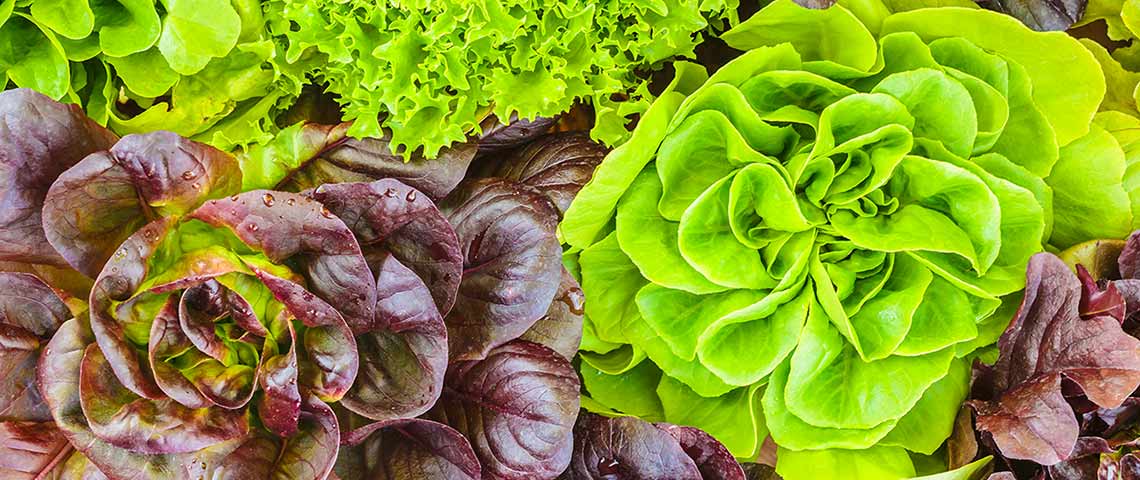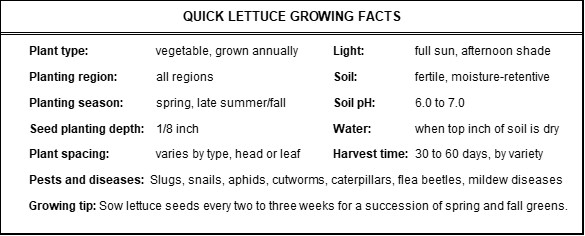How to Grow Lettuce

Lettuce is one of the easiest crops you can grow in your garden. That holds true whether you love full lettuce heads or baby lettuce leaves. Even if you garden in containers, you can have a bumper crop of leafy greens. Follow these tips on how to grow lettuce and leafy harvests and homegrown salads will be on your table soon enough.

Transplant lettuce seedlings to the garden when they're one month old.
LETTUCE-GROWING BASICS
When spring arrives, lettuce is one of the earliest crops you can plant outdoors. As soon as your soil is ready to be worked, lettuce seeds are good to go. Lettuce comes in many varieties, from head-forming butterheads to leaf lettuces that never form heads. You can even buy premixed seed packets that include colors from green to purple-red and textures from smooth and soft to crisp and heavily ruffled.
Lettuce seeds can germinate with soil temperatures of just 40 degrees Fahrenheit — not far above freezing. But lettuce plants grow best when air temperatures reach 60°F to 65°F.1 Like cabbage and other cool-loving vegetables, lettuce flourishes in cool spring weather, then lets you do it all again come fall. There are even lettuce varieties that tolerate more heat, but most lettuces grow tough, dry and bitter in summer heat.
Head-forming lettuces like romaine and butterhead take longer to grow and harvest than leafy lettuces. Spring is a race for heads to mature before temperatures rise too high. Many gardeners start their head lettuce seeds indoors to extend their growing season. Some garden centers offer small seedlings called transplants that accomplish the same goal. In contrast to head-forming lettuces, leafy types are much easier: Seed them straight into spring garden soil.

Direct-planted lettuce seeds can grow into wide, tight garden rows.
HOW TO PLANT AND TRANSPLANT LETTUCE
Lettuce is one of the few vegetables that tolerates a bit of shade. A planting site with full sun and late-afternoon shade is ideal — especially as summer nears. Well-drained soil with rich organic matter provides the perfect foundation for all lettuce types. Before you plant, mix organic compost and a balanced fertilizer such as Pennington Rejuvenate Plant Food All-Purpose 4-4-4 into your soil. Lettuce grows best when soil pH is between 6.0 and 7.0, the range where most plants thrive.
Lettuce transplants are garden-ready when they're three to four weeks old. Gradually acclimate transplants to the outdoors before you plant. Transplant head types such as romaine, iceberg and butterhead at 10- to 12-inch intervals, in rows 15 to 18 inches apart. If you're planting in pots or in mixed gardens, allow similar space.
For leaf lettuces, sow seed into garden soil. Plant four to six lettuce seeds per inch, in rows at least 2 inches apart. Many gardeners plant swaths of lettuces a foot wide — just keep widths manageable for harvesting. Lightly cover lettuce seeds with 1/8 inch of soil and press gently to ensure good seed-to-soil contact.
Depending on the variety, most lettuces mature between 30 and 60 days after planting. Your seed packet will specify what's normal for the lettuces you choose. Plant fall lettuce four to eight weeks before your area's first expected fall frost. For near-continuous spring and fall lettuce crops, plant seeds in succession plantings every two to three weeks.

Head-forming lettuces take longer for harvest than loose-leaf types.
HOW TO CARE FOR LETTUCE PLANTS
Proper watering is crucial to growing lettuce, regardless of the type. Crisp, juicy leaves need consistent soil moisture to grow properly and please your palate. Water lettuces whenever the top inch of soil gets dry. Warmer weather means more frequent watering.
Encourage robust leafy growth with regular feedings. A natural-based fish fertilizer such as Alaska Fish Fertilizer 5-1-1 provides nitrogen that lettuce needs. Weeds compete for water and nutrients, so keep your garden weed-free. A layer of organic mulch or clean, weed-free straw discourages weeds and helps maintain soil moisture.
Harvest head lettuces once heads are fully formed — or earlier if you like loose heads. Use a sharp, clean knife and cut at the soil line. Leaf lettuces offer more options. To keep leaf lettuce growing for more than one harvest, wait until leaves reach about 4 inches tall. Harvest the top 3 inches and leave the bottom inch intact. Then wait for another round.
For added fun, grow lettuce from kitchen scraps. Just place the base of the head in water and watch roots and leaves grow. Narrow-necked bulb vases work great to hold leaves high while roots grow in water below. It's a homegrown version of hydroponic lettuce growing that large-scale lettuce growers use.

Slugs and snails eat large holes in tender lettuce leaves.
TROUBLESHOOTING LETTUCE PROBLEMS
Unfortunately, many garden pests like tender lettuce leaves. Slugs and snails are two of the biggest offenders. If you're wondering what's eating your lettuce leaves, look for clues. Large, irregular holes and telltale slime are sure signs that slugs and snails are to blame. Aphids leave discolored spots where they suck lettuce leaves, but worms and caterpillars leave slug-like holes without slime trails attached.
Slugs and snails are mollusks, not insects, so it takes a special kind of pesticide to stop them. With Corry's Slug & Snail Killer ready-to-use pellets, slugs and snails stop feeding as soon as they eat the bait. Your family and pets can keep enjoying the garden while they do.
For other lettuce pests, such as aphids, cutworms, caterpillars, flea beetles and cabbage worms (which like lettuce as well as cabbage), a trusted insecticide such as Sevin Insect Killer Ready To Use2 kills insect pests before damage worsens.
Fungal diseases such as powdery mildew, leaf spot, root rot and downy mildew also attack lettuces, especially during persistent wet weather. Once fungal diseases are active, they can spread quickly, so prevention is the best control. Avoid overhead watering that wets lettuce leaves. Use drip irrigation or water the soil around the plants instead. Water early in the day so that leaves dry well in midday sun.
Lettuce flavors peak during cool weather and there's nothing quite like the first tender salad of spring — or fall. At Corry's, we're here to help you learn about gardening and the satisfaction that growing your own food and plants can bring. After all, we've been protecting plants for more than 70 years. So enjoy your lettuce, and happy gardening!

Always read product labels thoroughly and follow instructions, including guidelines for pre-harvest intervals (PHI) and application frequency.
Corry's is a registered trademark of Matson, LLC.
Lilly Miller and Alaska are registered trademarks of Central Garden & Pet Company.
Sevin is a registered trademark of Tessenderlo Kerley, Inc.
Source:
1. "Lettuce – Key Growing Information," Johnny's Selected Seeds.

